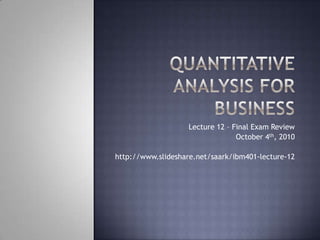
IBM401 Lecture 12
- 1. Quantitative Analysis for Business Lecture 12 – Final Exam Review October 4th, 2010 http://www.slideshare.net/saark/ibm401-lecture-12
- 2. Final exam No. of questions: 3 Duration: 3 hours Grade: 50% of final grade Topics: Everything
- 3. Linear regression Identifying independent and dependent variable The sample correlation coefficient for two variables Linear regression model form
- 4. Linear regression The assumptions of linear regression model are the following: A linear relations exists between the dependent variable and the independent variable. The independent variable is not random. The expected value of the error term is 0. The variance of the error term is the same for all observations The error term is uncorrelated across observations. The error term is normally distributed.
- 5. Linear regression In the regression model Yi = bo + b1Xi + Ei, if we know the estimated parameters, bo and b1, for any value of the independent variable, X, then the predicted value of the dependent variable Y is Y = b0 + b1X In simple linear regression, the F-test tests the same null hypothesis as testing the statistical significance of b1 (or the t-test) H0: b1 = 0 H1: b1 ≠ 0 If F > Fc, then reject H0 ^ ^
- 6. Multiple regression Multiple regression model Intercept – the value of the dependent variable when the independent variables are all equal to zero Each slope coefficient – the estimated change in the dependent variable for a one-unit change in the independent variable, holding the other independent variables contant Y = 0 + 1X1 + 2X2 + … + kXk +
- 7. Hypothesis testing of regression coefficients t-statistic – used to test the significance of the individual coefficient in a multiple regression t-statistic has n-k-1 degrees of freedom Estimated regression coefficient – hypothesized value Coefficient standard error of bj
- 8. F-statistic F-test assesses how well the set of independent variables, as a group, explains the variation of the dependent variable F-statistic is used to test whether at least one of the independent variables explains a significant portion of the variation of the dependent variable
- 9. Coefficient of determination (R2) Multiple coefficient of determination, R2, can be used to test the overall effectiveness of the entire set of independent variables in explaining the dependent variable.
- 10. Adjusted R2 Unfortunately, R2 by itself may not be a reliable measure of the multiple regression model R2 almost always increases as variables are added to the model We need to take new variables into account Where n = number of observations k = number of independent variables Ra2 = adjusted R2
- 11. Adjusted R2 Whenever there is more than 1 independent variable Ra2 is less than or equal to R2 So adding new variables to the model will increase R2 but may increase or decrease the Ra2 Ra2 maybe less than 0 if R2 is low enough
- 12. Time-Series Models Time-series models attempt to predict the future based on the past Common time-series models are Moving average Exponential smoothing Trend projections Decomposition Regression analysis is used in trend projections and one type of decomposition model
- 13. Decomposition of a Time-Series A time series typically has four components Trend (T) is the gradual upward or downward movement of the data over time Seasonality (S) is a pattern of demand fluctuations above or below trend line that repeats at regular intervals Cycles (C) are patterns in annual data that occur every several years Random variations (R) are “blips” in the data caused by chance and unusual situations
- 17. Exponential Smoothing with Trend Adjustment The equation for the trend correction uses a new smoothing constant Tt is computed by where Tt+1 = smoothed trend for period t + 1 Tt = smoothed trend for preceding period = trend smooth constant that we select Ft+1 = simple exponential smoothed forecast for period t + 1 Ft = forecast for pervious period
- 18. Seasonal Variations with Trend When both trend and seasonal components are present, the forecasting task is more complex Seasonal indices should be computed using a centered moving average (CMA) approach There are four steps in computing CMAs Compute the CMA for each observation (where possible) Compute the seasonal ratio = Observation/CMA for that observation Average seasonal ratios to get seasonal indices If seasonal indices do not add to the number of seasons, multiply each index by (Number of seasons)/(Sum of indices)